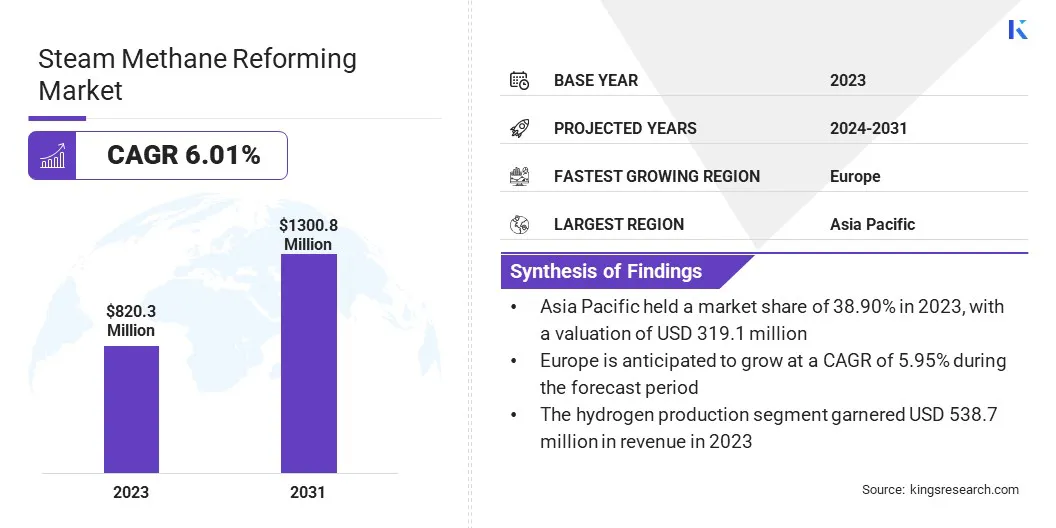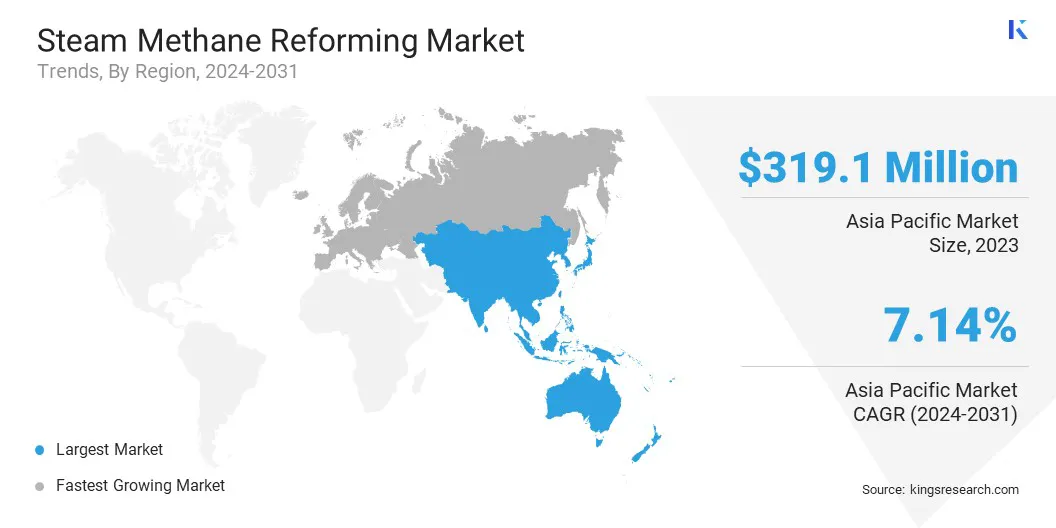The global Steam Methane Reforming Market size was valued at USD 820.3 million in 2023 and is projected to grow from USD 864.7 million in 2024 to USD 1,300.8 million by 2031, exhibiting a CAGR of 6.01% during the forecast period. The growth of the market is driven by the increasing demand for hydrogen as a clean energy source, ongoing technological advancements in reforming processes, and stringent environmental regulations that promote low-emission solutions.
In the scope of work, the report includes solutions offered by companies such as Air Liquide Engineering & Construction, Axens, DuPont de Nemours, Inc., Exxon Mobil Corporation, John Wood Group PLC, Linde PLC, Lummus Technology, McDermott, Shell Catalysts & Technologies, KBR, Inc., and others.
The expansion of the steam methane reforming (SMR) market is fueled by the increasing demand for hydrogen across various industries, particularly in petroleum refining, ammonia production, and methanol synthesis. The global shift toward cleaner energy solutions and stringent regulations on carbon emissions are propelling the adoption of hydrogen as a cleaner alternative.
- For instance, in March 2024, the EPA introduced new standards to further reduce air pollutant emissions from medium-duty and light-duty vehicles, starting with models from the 2027 model year. This rule builds upon previously existing emissions standards and leverages advancements in clean car technology to reduce climate pollution, improve public health, and lower fuel and maintenance costs for drivers. The standards are anticipated to be implemented gradually from model years 2027 to 2032.
Technological advancements in SMR processes, aimed at improving efficiency and reducing environmental impact, further support market growth. Additionally, the availability of natural gas as a primary feedstock for SMR, coupled with its relatively low cost, enhances the attractiveness of this hydrogen production method, thereby fostering market expansion.
The steam methane reforming market is experiencing significant growth, propelled by rising hydrogen consumption across diverse sectors. The Asia-Pacific region dominates the market due to rapid industrialization and substantial investments in hydrogen infrastructure.
The market is characterized by a combination of established companies and emerging players, all of which are focused on optimizing SMR technology to meet the growing demand. Strategic collaborations, rising research and development activities, and government incentives play pivotal roles in shaping the competitive landscape and fostering market expansion.
Steam methane reforming (SMR) is a chemical process used to produce hydrogen from natural gas. The process involves the reaction of methane with steam under high temperatures and pressures, typically in the presence of a catalyst, to produce hydrogen, carbon monoxide, and carbon dioxide.
SMR is the most common and cost-effective method for large-scale hydrogen production, accounting for a significant share of global hydrogen output. This process is integral to industries that demand high-purity hydrogen and is crucial for applications such as fuel cells, refining, and chemical synthesis.

Analyst’s Review
Manufacturers are making significant efforts to innovate and optimize steam methane reforming (SMR) technology. Key market players are investing heavily in advanced catalysts and integrating carbon capture and storage (CCS) to reduce emissions. New products, such as more efficient SMR units and hybrid systems combining SMR with renewable energy sources, are being introduced to the market.
These innovations are crucial for aligning with global sustainability goals. Analysts recommend that companies continue to focus on R&D to enhance process efficiency and reduce environmental impact. Additionally, forming strategic partnerships and leveraging government incentives are anticipated to strengthen market positions. Emphasizing sustainability and technological advancements are likely to play a crucial role in long-term success in the steam methane reforming market.
- For instance, in May 2024, Ferroman and Lummus Technology announced a partnership to advance digitalization and decarbonization in their operations, along with delivering high-performance equipment. The agreement involved Lummus Digital, a joint venture between Lummus Technology and TCG Digital, which contributed through system optimization, performance monitoring, and other enterprise-level services. The collaboration leverages combined technology and expertise to accelerate digitalization and support sustainability in the industry.
The growing emphasis on clean energy solutions is supporting the expansion of the market. As countries and industries focus on reducing carbon footprints, the demand for hydrogen as a clean energy carrier is increasing. Governments are implementing stricter environmental regulations, thereby promoting the adoption of hydrogen-based technologies.
Companies are investing heavily in hydrogen production to align with sustainability goals and to tap into emerging markets. The versatility of hydrogen in various applications, from fuel cells to industrial processes, is further fueling its demand, making steam methane reforming a crucial technology to meet this rising demand.
A significant challenge impeding the growth of the steam methane reforming market is the emission of carbon dioxide generated during the hydrogen production process. This environmental concern is impacting the adoption of SMR technology. To overcome this challenge, companies are investing heavily in carbon capture and storage (CCS) technologies.
The integration of CCS with SMR results in a significant reduction of carbon dioxide emissions, making the process more environmentally friendly. Additionally, research is actively being conducted to develop more efficient catalysts and alternative reforming methods that produce fewer emissions. These advancements are crucial for aligning SMR with global sustainability goals and ensuring its continued relevance in the hydrogen economy.
The integration of renewable energy sources with steam methane reforming is emerging as a notable trend. Companies are increasingly combining SMR with renewable energy technologies such as solar and wind to produce green hydrogen. This approach assists in reducing the carbon footprint of hydrogen production and aligns with global sustainability initiatives.
The use of renewable energy to power the reforming process or to generate the steam required in SMR is gaining significant traction. This trend is further fueled by the rising need for cleaner hydrogen production methods and the growing availability of renewable energy resources, making green hydrogen a viable and attractive option.
Digitalization and automation in steam methane reforming processes are influencing the steam methane reforming market. Advanced analytics, artificial intelligence, and machine learning are being utilized to optimize SMR operations, enhance efficiency, and reduce operational costs.
Automation technologies are improving process control, minimizing human error, and ensuring consistent hydrogen production quality. Companies are investing heavily in digital solutions to monitor and manage SMR plants remotely, enabling predictive maintenance and reducing downtime. This trend towards digital transformation is enhancing the competitiveness of SMR technology, rendering it more efficient and adaptable to the evolving demands of the hydrogen market.
Segmentation Analysis
The global market is segmented based on application, end use industry, and geography.
By Application
Based on application, the market is categorized into ammonia production, methanol production, hydrogen production, and others. The hydrogen production segment led the steam methane reforming market in 2023, reaching a valuation of USD 538.7 million. This notable expansion is largely attributed to the increasing demand for hydrogen across various industries.
The shift toward cleaner energy alternatives and stricter environmental regulations are underscoring the rising need for hydrogen, which is considered a clean and efficient energy carrier. Technological advancements in steam methane reforming are improving the efficiency and cost-effectiveness of hydrogen production.
Additionally, investments in hydrogen infrastructure, such as refueling stations and storage facilities, are supporting the growth of the segment, making hydrogen a critical component in the transition to a sustainable energy future.
By End Use Industry
Based on end use industry, the market is classified into chemicals & oleochemicals, steel and metal processing, edible oil processing, electronic & semiconductor, refuelling station, and energy sector. The electronic and semiconductor segment is poised to witness significant growth at a robust CAGR of 9.79% through the forecast period (2024-2031).
This growth is fostered by the increasing use of hydrogen in semiconductor manufacturing processes, where it is essential for creating a controlled environment. The rising demand for electronic devices and ongoing advancements in semiconductor technology are boosting the need for high-purity hydrogen.
The integration of steam methane reforming technology to produce hydrogen for the semiconductor industry is becoming increasingly prevalent. Additionally, the expansion of the electronics market, supported by innovations in consumer electronics and industrial applications, is contributing to the growth of the segment.
Based on region, the global market is classified into North America, Europe, Asia Pacific, MEA, and Latin America.

Asia-Pacific steam methane reforming market captured a share of around 38.90% in 2023, with a valuation of USD 319.1 million. This dominance is reinforced by rapid industrialization, especially in countries such as China, India, and Japan.
The region's strong focus on increasing hydrogen production to support various industries, including refining, chemicals, and manufacturing, is further supporting this growth. Additionally, government initiatives that promote the use of cleaner energy solutions and significant investments in hydrogen infrastructure are aiding regional market growth. The availability of natural gas and ongoing advancements in SMR technology further foster the expansion of the Asia-Pacific market.
Europe is poised to experience significant growth at a CAGR of 5.95% over the forecast period. This growth is fueled by the region's stringent environmental regulations and commitment to reducing carbon emissions. European countries are investing heavily in hydrogen production as part of their transition to renewable energy sources.
Initiatives such as the European Green Deal are promoting the use of hydrogen as a key element in achieving climate neutrality. Additionally, technological advancements and research in sustainable SMR methods, combined with substantial funding and collaboration between public and private sectors, are propelling the steam methane reforming market expansion.
Competitive Landscape
The global steam methane reforming market report will provide valuable insight with an emphasis on the fragmented nature of the industry. Prominent players are focusing on several key business strategies such as partnerships, mergers and acquisitions, product innovations, and joint ventures to expand their product portfolio and increase their market shares across different regions.
Manufacturers are adopting a range of strategic initiatives, including investments in R&D activities, the establishment of new manufacturing facilities, and supply chain optimization, to strengthen their market standing.
List of Key Companies in Steam Methane Reforming Market
Key Industry Developments
- June 2024 (Partnership): Air Liquide and ExxonMobilentered into an agreement to produce low-carbon ammonia and hydrogen at ExxonMobil’s Baytown, Texas facility. Air Liquide agreed to build and operate four Large Modular Air separation units to supply oxygen and nitrogen, primarily using low-carbon electricity. The facility is set to produce significant quantities of hydrogen and ammonia while capturing over 98% of CO2 emissions, thereby contributing significantly to industrial decarbonization efforts.
- November 2023 (Expansion): Air Products announced plans to construct and operate a state-of-the-art carbon capture facility at its hydrogen plant in Rotterdam, Netherlands, with an expected operational date of 2026. This facility is likely to be the largest blue hydrogen plant in Europe once completed, designed to supply ExxonMobil’s Rotterdam refinery and other customers via Air Products' pipeline network. The project involves capturing CO2 emissions from existing operations and storing them in depleted North Sea gas fields, aligning with Dutch climate targets.
The global steam methane reforming market is segmented as:
By Application
- Ammonia Production
- Methanol Production
- Hydrogen Production
- Others
By End Use Industry
- Chemicals & Oleochemicals
- Steel and Metal Processing
- Edible Oil Processing
- Electronic & Semiconductor
- Refuelling Station
- Energy Sector
By Region
- North America
- Europe
- France
- U.K.
- Spain
- Germany
- Italy
- Russia
- Rest of Europe
- Asia-Pacific
- China
- Japan
- India
- South Korea
- Rest of Asia-Pacific
- Middle East & Africa
- GCC
- North Africa
- South Africa
- Rest of Middle East & Africa
- Latin America
- Brazil
- Argentina
- Rest of Latin America


